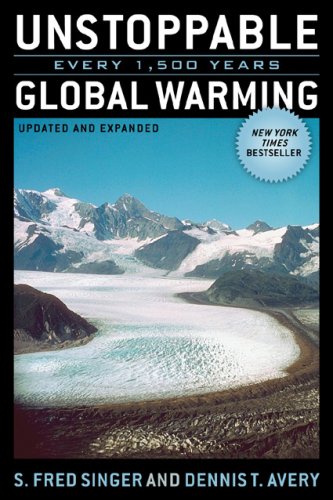

| UNSTOPPABLE GLOBAL WARMING (rev. ed.) Every 1,500 Years S. Fred Singer Dennis T. Avery Joseph L. Bast (Fwd.) Lanham, MD: Rowman & Littlefield, October 2007 |
Rating: 1.0 Poor |
|||
| ISBN-13 978-0-7425-5124-4 | ||||
| ISBN 0-7425-5124-5 | 278pp. | SC/BWI | $21.95 | |
In Chapter 2, the authors describe the hypothesis of Dr. Henrik Svensmark, who posits that the Sun's modulation of the cosmic-ray flux reaching Earth's atmosphere constitutes a climate forcing function. When the Sun is in an active period (marked by high numbers of sunspots), the more intense solar wind lowers the cosmic-ray flux at Earth; conversely, a quiet Sun permits a rise in cosmic-ray impacts. The climate connection arises because, in Svensmark's hypothesis, cosmic rays create ionized particles in the atmosphere that act as condensation nuclei, "seeding" the formation of clouds. Thus, more cosmic rays mean more clouds, cooling the Earth. When the Sun is active, however, fewer clouds form. Earth gets a temperature "double-whammy" — more light from the Sun, and fewer clouds to block it.
It is well known that charged particles cause condensation along their tracks. Particle physicists have used this fact for decades to make the tracks visible in the cloud chamber, once an essential tool of their trade. But outside the controlled conditions of the chamber, other factors come into play. It is unclear at present how well Svensmark's hypothesis holds up. One obvious piece of evidence against it is that the Sun is currently quiet. Thus, if Svensmark is right we should be seeing more cloud cover and less warming; instead we are seeing the opposite.
But let me examine the authors' defense (pages 29-30)...
But only recently have scientists found the mechanism that explains how small changes in solar irradiance can cause large changes in Earth's climate. In 2002, BBC News reported the discovery:
"German scientists have found a significant piece of evidence linking cosmic rays to climate change. They have detected charged-particle clusters in the lower atmosphere that were probably caused by the [cosmic rays]. They say the clusters can lead to condensed nuclei which form into dense clouds ... The amount of cosmic rays reaching Earth s largely controlled by the Sun, and many solar scientists believe the star's indirect influence on Earth's global climate has been underestimated."
Here is the sun-climate hypothesis—that tiny variations in the sun's irradiance are amplified into major climate changes on Earth by at least two factors: (1) cosmic rays creating more or fewer of the low, cooling clouds in the Earth's atmosphere; and (2) solar-driven ozone changes in the stratosphere creating more or less heating of the lower atmosphere. A third process—the ocean-iron ore feedback loop, may also be important.
First, the ocean-iron ore feedback is totally unrelated to Svensmark's hypothesis. I'm not sure why it is included in this chapter, but we can dismiss it from discussion of that hypothesis.
Second, as I mentioned, the fact that the sun is in a quiet phase at present would lead to the conclusion that more cosmic rays reach the Earth and the planet should therefore be cooling. Denialist claims for the past fifteen years to the contrary, that is not what we observe.
Third, regarding the matter of solar-driven ozone changes: ozone is a greenhouse gas. If the sun were more active, presumably a greater ultraviolet (UV-A) flux would create more ozone in the stratosphere which in turn would cause more heating. But as I read the authors' claim, ambiguous though it is ("more or less heating"), this is the opposite of what they say should happen.
The bottom line, then, is that while Svensmark's hypothesis and the other ideas presented in Chapter 2 are not disproven, there is scant evidence for the entire chain of causation at present and if there were evidence, it would not support the authors in asserting that Earth should now be cooling.

 To contact Chris Winter, send email to this address.
To contact Chris Winter, send email to this address.